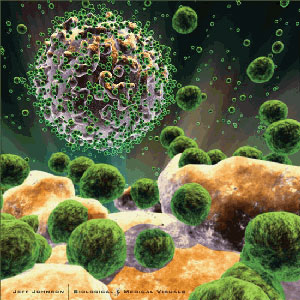 Photo by Jeff Johnson HIV virus infecting a cell |
That’s a significant increase in the rate of evolutionary development. The standard cited mechanisms for evolution are point mutations–“random changes in single nucleotides on the DNA chain, or genome”–and recombination, which occurs when the genetic sequences of a set of parents are recombined (“sexual selection”). But models that simply take into account these two common mechanisms really don’t explain the sudden rapid acceleration of evolutionary rates indicated by the fossil record.
Enter Rice University physicist-turned-bioengineer Michael Deem, who has a penchant for adapting mathematical models from physics to the mutation and evolution of the flu virus, among other research. At the APS March Meeting in Denver, Deem reported that he has now developed “the first exact solution of a mathematical model of evolution that accounts for this cross-species genetic exchange.” He attributes the phenomenon to horizontal gene transfer (HGT), in which the DNA from one species is introduced into another.
Deem found that by accounting for HGT–in addition to point mutations and sexual recombination–his model can demonstrate how HGT increases the rate of evolution by spreading favorable mutations across populations.
So it is possible to swap entire sets of genetic code, including the genes that allow bacteria to develop resistance to antibiotics–and for the human immune system to continually adapt to invasive species, an attribute Deem has traced to an HGT insertion that occurred some 400 million years ago. In fact, he thinks that a significant portion of our DNA was donated by viruses and bacteria that infected our ancestors over lots and lots of generations. “Life clearly evolved to store genetic information in a modular form, and to accept useful modules of genetic information from other species,” said Deem.
Deem’s prior work on flu vaccines–notably, the use of nuclear spin glass modeling to better predict which strain of the flu virus was likely to dominate in any given year–exploited the phenomenon of “original antigenic sin.” The antibodies produced by the body’s immune system to fight exposure to the flu virus become part of the body’s “memory” so that it can fight off future exposure to the same flu strain. However, those same antibodies end up suppressing the creation of new antibodies when the body is exposed to a new strain of the flu.
The phenomenon has also been observed in dengue fever and HIV. The latter was the topic of a second paper by Deem’s research group presented at the Denver meeting. HIV is an especially difficult virus to eradicate, in part because it mutates so quickly after initial infection, producing several different virus strains. It’s an ingenious “divide and conquer” strategy, according to Deem: the human immune system responds to viral infection by producing antibodies to ward off any given strain, but it tends to only focus on a single strain; the rest just run rampant.
T-cell competition takes two forms, per Deem’s computer models: original antigenic sin (also known as “deceptive imprinting”), and immunodominance, which occurs when several viral strains simultaneously infect a single person. The cells that respond to each strain compete until one emerges the victor.
“Once the immune system chooses a winning set of T-cells, it has a natural tendency to go with those cells when it’s confronted by new strains of the same disease in the future,” said Deem. “For HIV, we found a direct correlation between the level of competition among T-cells and the rate at which the virus escaped.”
Deem has devised a potential new strategy for a more effective HIV vaccine. He thinks that inoculating someone at various points on the body against different strains simultaneously could all but eliminate competition among T-cells, so that the HIV will be trapped in a permanently latent state, never raging out of control to develop into full-blown AIDS.
There are lymph nodes scattered throughout the body, responsible for producing those all-important T-cells, but it takes four or five days before any T-cells produced therein leave the node and spread throughout the body. Simultaneous inoculation would mean that each different node would select for a different strain, with no single T-cell emerging as dominant, because immunodominance doesn’t have time to kick in.
©1995 - 2024, AMERICAN PHYSICAL SOCIETY
APS encourages the redistribution of the materials included in this newspaper provided that attribution to the source is noted and the materials are not truncated or changed.
Contributing Editor: Jennifer Ouellette
Staff Writer: Ernie Tretkoff
May 2007 (Volume 16, Number 5)
Articles in this Issue

